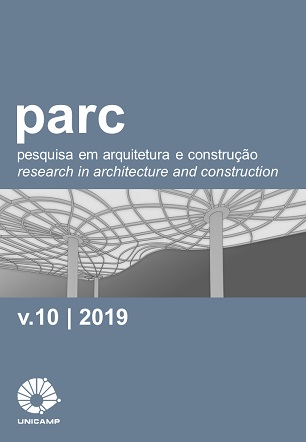Abstract
This study aimed to characterize the thermal comfort of the vernacular architecture produced by Pomeranian descendants in southern Brazil, based on in-situ data collection of external and internal characteristics. External characteristics were analyzed for a total of 126 houses. These data were used to carry out a preliminary classification of regional architectural types. Then, 18 houses were selected, from the 126 analyzed previously, for the collection of architectural and construction data, obtaining a final classification of four architectural types, corresponding to different materials and constructive periods. The four selected types are within a 100-year time period (1870 to 1970), and were analyzed regarding thermal comfort. Results showed that the different types did not present high levels of comfort. The solar orientation had little influence on comfort results, and no significant differences were observed between the different types, although houses of type IV presented a slight thermal comfort improvement, when compared to the other architectural types. These few variations of the thermal behavior between the different solar orientations and the different architectural types could be explained by the high thermal capacity of the walls and the small window-to-wall opening area that the houses present, maintaining internal temperatures with a less variation, in comparison to the outdoor environment. Through this work, it was possible to address the complex interaction between climate, culture, and technology in the studied dwellings.
References
ABNT - ASSOCIAÇÃO BRASILEIRA DE NORMAS TÉCNICAS. NBR 15220: Desempenho térmico de edificações. Rio de Janeiro, 2005.
ALVARES, C. A.; STAPE, J. L.; SENTELHAS, P. C.; GONÇALVES, J. L. M.; SPAROVEK, G. Köppen Climate Classification Map for Brazil. Meteorologische Zeitschrift, v.22, n.6, p. 711-728, 2014. DOI:http://doi.org/10.1127/0941-2948/2013/0507
ASHRAE – AMERICAN NATIONAL STANDARD INSTITUTE/ AMERICAN SOCIETY OF HEATING, REFRIGERATING AND AIRCONDITIONING ENGINEERS. Standard – 55: Thermal environmental conditions for human occupancy. Atlanta, 2017.
BODAC, S.; LANG, W.; HAMHABER, J. Climate Responsive Building Design Strategies of Vernacular Architecture in Nepal. Energy and Buildings, v.81, p. 227-242, 2014. DOI:http://dx.doi.org/10.1016/j.enbuild.2014.06.022
ÇENGEL, Y. A.; GHAJAR, A. J. Transferência de calor e massa: uma abordagem prática. 4. edição. São Paulo: McGraw-Hill, Bookman, 2012. 902 p.
CIBSE - CHARTERED INSTITUTION OF BUILDING SERVICES ENGINEERS. Guide A: Environmental Design. 7. ed. London: CIBSE, 2006.
CHANDEL, S. S.; SHARMA, V.; MARWAH, B. M. Review of energy Efficient Features in Vernacular Architecture for Improving Indoor Thermal Comfort Conditions. Renewable and Sustainable Energy Reviews, v.65, p. 459-477, 2016. DOI:http://dx.doi.org/10.1016/j.rser.2016.07.038
DESOGUS, G.; CANNAS, L. G. F.; SANNA, A. Bioclimatic Lessons from Mediterranean Vernacular Architecture: The Sardinian Case Study. Energy and Buildings, v.129, p. 574-588, 2016. DOI:http://dx.doi.org/10.1016/j.enbuild.2016.07.051
GRANZOW, K. Pomeranos sob o Cruzeiro do Sul: colonos alemães no Brasil. Arquivo público do estado do Espírito Santo. Vitória, 2009. 146 p.
HAMMES, E. L. A imigração alemã para São Lourenço do Sul – Da formação de sua colônia aos primeiros anos após seu sesquicentário. 1. ed. São Leopoldo: Studio Zeus, 2014. 734 p.
HELENA, C. Bioclimatism in vernacular architecture. Renewable and Sustainable Energy Reviews, v.2, n.1, p. 67-87, 1998.
IBGE - INSTITUTO BRASILEIRO DE GEOGRAFIA E ESTATÍSTICA –. Censo Agropecuário 2006. Disponível em: www.ibge.org.br. Acessado em: 05/04/2017.
KALOGIROU, S. A.; FLORIDES, G.; TASSOU, S. Energy Analysis of Buildings Employing Thermal Mass in Cyprus. Renewable Energy, v.27, n.3, p. 353-368, 2002. DOI:http://doi.org/10. 1016/S0960-1481 (02)00007-1
KRONE, E. E. Comida, Memória e Patrimônio Cultural: A Construção da Pomeranidade no Extremo Sul do Brasil. 2014. 175 p. Dissertação (Mestrado em Antropologia) – Programa de Pós Graduação em Antropologia, Universidade Federal de Pelotas, Pelotas, 2014.
LEO SAMUEL, D. G.; DHARMASASTHA, K.; SHIVA NAGENDRA, S. M.; PRAKASH MAIYA, M. Thermal Comfort in Traditional Buildings Composed of Local and Modern Construction Materials. International Journal of Sustainable Built Environment, v.6, n.2, p. 463-475, 2017. DOI:http://doi.org/10.1016/j.ijsbe.2017.08.001
MARTINS, D. J.; RAU, S. L.; RECKZIEGEL, S.; FERRUGEM, A. P.; SILVA, A. C. S. B. Ensaio Sobre a Utilização de Aberturas na Simulação do Desempenho Térmico de Edificações. In: ENCONTRO NACIONAL. & ENCONTRO LATINO AMERICANO DE CONFORTO NO AMBIENTE CONSTRUÍDO, 6., Natal, 2009. Anais [...]. Natal: ENTAC, 2009. p. 865-874.
MICHAEL, A.; DESMOSTHENOUS, D.; PHILOKYPROU, M. Natural Ventilation for Cooling in Mediterranean Climate: A Case Study in Vernacular Architecture of Cyprus. Energy and Buildings, v.144, p. 333-345, 2017. DOI:http://dx.doi.org/10.1016/j.enbuild.2017.03.040
PREVITALI, J. M.; ZHAI, Z. A Taxonomy of Vernacular Architecture an Addendum to “Ancient Vernacular Architecture: Characteristics Categorization and Energy Performance Evaluation”. Energy and Buildings, v.110, p. 71-78, 2016. DOI: http://dx.doi.org/10.1016/j.enbuild.2015.10.015
PROCEL - PROGRAMA NACIONAL DE CONSERVAÇÃO DA ENERGIA ELÉTRICA. Regulamento Técnico da Qualidade para o Nível de Eficiência Energética nas Edificações Residenciais, RTQ-R. 2012. Disponível em: www.procelinfo.com.br. Acesso em: 05/04/2017.
RAKOTO-JOSEPH, O.; GARDE, F.; DAVID, M.; ADELARD, L.; RANDRIAMANANTANY, Z. A. Development of Climate Zones and Passive Solar Design in Madagascar. Energy Conversion and Management, v.50, n.4, p. 1004-1010, 2009. DOI:http://dx.doi.org/10.1016/j.enconman.2008.12.011
SILVA, H. S.; SANTOS, M. C. O. O Significado do Conforto no Ambiente Residencial. Cadernos do PROARQ, v.18, p. 136-151, 2012.
SOLEYMANPOUR, R.; PARSAEE, N.; BANAEI, M. Climate Comfort Comparison of Vernacular and Contemporary Houses of Iran. Procedia – Social and Behavioral Sciences, v.201, p. 49-61, 2015. DOI:https://doi.org/10.1016/j.sbspro.2015.08.118
SUPIC, P. Vernacular Architecture: A Lesson of the Past for the Future. Energy and Buildings, v.5, p. 43-54, 1982.
THUM, C. Educação, História e Memória: silêncios e Reinvenções Pomeranas na Serra dos Tapes. 2009. 384 p. Tese (Doutorado em Educação) – Programa de Pós Graduação em Educação, universidade Vale dos Sinos, São Leopoldo, 2009.
WESTPHAL, F. S. Análise de Incertezas e de Sensibilidade Aplicadas à Simulação de Desempenho Energético de Edificações Comerciais. 2007. 147 p. Tese (Doutorado em Engenharia Civil) – Faculdade de Engenharia, Universidade Federal de Santa Catarina, Florianópolis, 2007.

This work is licensed under a Creative Commons Attribution 4.0 International License.
Copyright (c) 2019 PARC Research in Architecture and Building Construction

